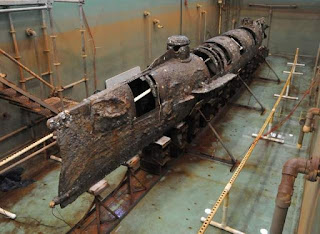Like the state they come from, the Texas Longhorn has had
its ups and downs with a near extinction thrown in. Known for its extended rack of horns (up to
six feet from tip to tip), the legendary bovine has amazing durability,
extraordinary adaptability, and were easy to herd on extended cattle drives. Unlike other cattle breeds, the Texas
Longhorn is the only breed to have developed naturally within the United
States.
The Longhorn originated from feral cattle brought over by
the Spaniards then released over time on the open range. After two centuries, they were cross-bred with
English cattle brought over by U.S. settlers.
By the time of the Civil War, a distinct American cow had emerged. After the great buffalo herds were hunted
off, wild longhorns took their place on the rich grazing lands of the Great
Plains. As longhorn herds grew, so did
the demand for beef. The problem was rounding
them up and getting them to market. Inclement
weather, hostile Indians, and cattle rustlers were just a few of the hazards.
The cattle drive was developed to herd thousands of cattle across
Texas, the Indian Territory and Kansas to the railroads that carried them to packing
plants back East. For twenty years, the
cattle drives brought ten million cows to Kansas rail heads. The average drive usually required ten to
fifteen cowboys, along with a cook, to manage it. Longhorns
had the long legs and tough hooves to travel long distances. Also, they had the horns to fight off
predators. What they didn’t have was a less
than skittish nature. Loud sudden
noises, like thunder, or the flash of a match lighting a cigarette could set
off a stampede. Cowboys would try to
stop a stampede by dispatching their best riders to the front of the herd where
they reigned in their horses to slow it down.
Another trick was to turn the herd by waving their coats or firing their
pistols near the longhorns’ heads, forcing them to change their direction. If a cowboy fell from his saddle, he was at risk
of being trampled.
In the early 1880’s, a fatal cattle disease brought about a
quarantine followed by legislation banning longhorns from Kansas. Texas fever was carried by ticks that
dropped from their immune longhorn hosts and infected Northern cattle
breeds. Kansas dirt farmers, armed with
Winchesters, would block cattle drives at the border. Sometimes the farmers were actually
extortionists or cattle rustlers looking for a cash payment or a cut of the
herd before letting the cattle pass. One
trail hand recounted what his boss did when a group tried to stop his drive:
‘The Old Man got a shotgun loaded with buckshot and led the
way, saying: “John, get over on that point with your Winchester and point these
cattle in behind me.” He slid his
shotgun across the saddle in front of him and we did the same with our
Winchesters. He rode right across, and
as he rode up to them, he said: “I’ve monkeyed as long as I want to with you,”
and they fell back to the sides, and went home after we passed. If they had done a thing, we would have
filled them so damned full of lead they’d never have got away.’
Other trail bosses complied with the farmers and turned
their herds west. “Bend em West boys,”
one frustrated boss ordered. “Nothing in
Kansas anyhow except the three suns – sunflowers, sunshine and sons-of-bitches.”
The barbed wire fence brought about the end of open range
cattle raising and long cattle drives. Cattlemen turned to railroads instead to get
their cows to market. By 1927, the longhorns were almost bred out of
existence. For ranchers, the quality of
beef replaced a longhorn’s durability.
To save the few remaining longhorn herds, wealthy Texas oilmen and
government officials placed longhorn herds on wildlife refuges in Texas and
Oklahoma. The Texas Longhorn is now a
curiosity, but a new demand for lean longhorn beef has emerged from diet
conscious Americans. The Longhorn is
also assisted by being the mascot for the University of Texas.
Famed cattle baron, Charles Goodnight, best summed up the
qualities of the Longhorn:
“As trail cattle their equal has never been known and never
will be. Their hoofs are superior to
those of any other cattle. In stampedes
they hold together better, are easier circled in a run, and rarely split off
when you commence to turn the front. No
animal of the cow kind will shift and take care of itself under all conditions
as will the longhorns. They can go
farther without water and endure more suffering than others.”












